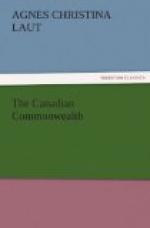II
What are the facts?
De Monts’ first charter to Arcadia dates 1605. The first charter for Virginia plantations comes in 1606, and the first New England charter dates the same year. The United States and Canada are both fertile. They have almost the same area in square miles. One has a population of over ninety millions and a foreign commerce of four billions. The other has a population of about eight millions and a foreign commerce of one billion. One raises from seven hundred to nine hundred million bushels of wheat; the other, from two hundred to three hundred millions. One produces thirty million metric tons of steel a year; the other, less than a million tons; one is worth a hundred and fifty billion dollars, the other perhaps ten billions.
It is explained that the northern belt of Canada lying in a semi-arctic zone should hardly be included in comparisons with the area of the United States lying altogether in a temperate zone; but if cultivation is proving one thing more than another, it is that Canada’s arctic region recedes a little every year, and her isothermal lines run a little farther north every year. To put it differently, it is being yearly more and more proved that the degree of northern latitude matters less in vegetable growth than heretofore thought, if the arable land be there; for the simple reason that twenty hours of sunlight from May to September force as rapid a growth as twelve to fifteen hours’ sunlight from March to September, and the product grown in the North may be superior to that grown farther south. Wheat from Manitoba is better than wheat from Georgia. Apples from Niagara have a quality not found in apples—say from the Gulf states. All things will not grow in northern latitudes. You can’t raise corn. You can’t raise peaches. I doubt if any apple will ever be found suitable for the northwestern prairie. At any rate, it has not yet been found.
Half a century ago the Governor of the Hudson’s Bay Company in perfectly good faith testified before a committee of the Imperial Commons that farming could never be carried on in Rupert’s Land, or what are now known as Manitoba, Saskatchewan and Alberta. He proved that grain could not be grown there. I recall the day when the idea of fall wheat west of Lake Superior elicited a hoot of derision. I have lived to wander through fields of six hundred acres north of the Saskatchewan. Thirty years ago any one suggesting settlement on Peace River, or at Athabasca, would have been regarded as a visionary fool. Yet wheat is ground into flour on Peace River, and the settler is at Athabasca; and soft Kansas fall wheat sent to Peace River has by a few years’ transplanting been transformed into Number One Hard spring wheat. Canada’s arctic belt has shrunk a little each year, and her isothermal lines gone a little farther north. The only limit to growth in the North Country is the nature of the soil.




